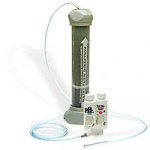ChrisRD":34vfhljm said:
I believe he's saying that most commonly available membranes rated for 100 GPD are typically designed for high output and tend to not have as good of a rejection rate, ie. 90% as opposed to the 98% often seen for the lower flow models. I discussed this with an RO vendor on the phone a few years ago and was told the same thing...
Yep, that pretty much sums it up.
AFAIK, all the 100 gpd RO sold to the hobby has a 90% rejuction rate. I have even seen quite a few online discussions say that the 100+ gpd are not technically RO membranes.
That said, with good prefilters (mainly to protect the RO membrane), carbon block (to break down the chlorine and chloramine), 100 gpd membrane and the standard size DI (not the small horizontal ones), you should be good to go with 350 ppm tap TDS. The only down side is the with the lower rejection rate of the 100 gpd, your DI won't last as long. I personally prefer the 75 gpd which has a 98% rejection rate.
Still, I'm not sure why with a TDS of 35 ppm after the RO, you are still getting 4 ppm from the first DI. With a new cartridge you should get 0 TDS, but it will be used up quicker than if the output from the RO was 5 ppm.
Like I said, I used to get 0 uS/cm (0 TDS) using the tap water filter below which just basically is a DI cartridge. No RO to help. If your water is bad it just doesn't last too long, maybe 50 gals.
Phosphates, ammonia and silicates will get caught by the DI, but ammonia and silicates are also the first to be given up when a DI cartridge is depleted. This is why the moment you see the TDS after the DI starting to climb, change it.






